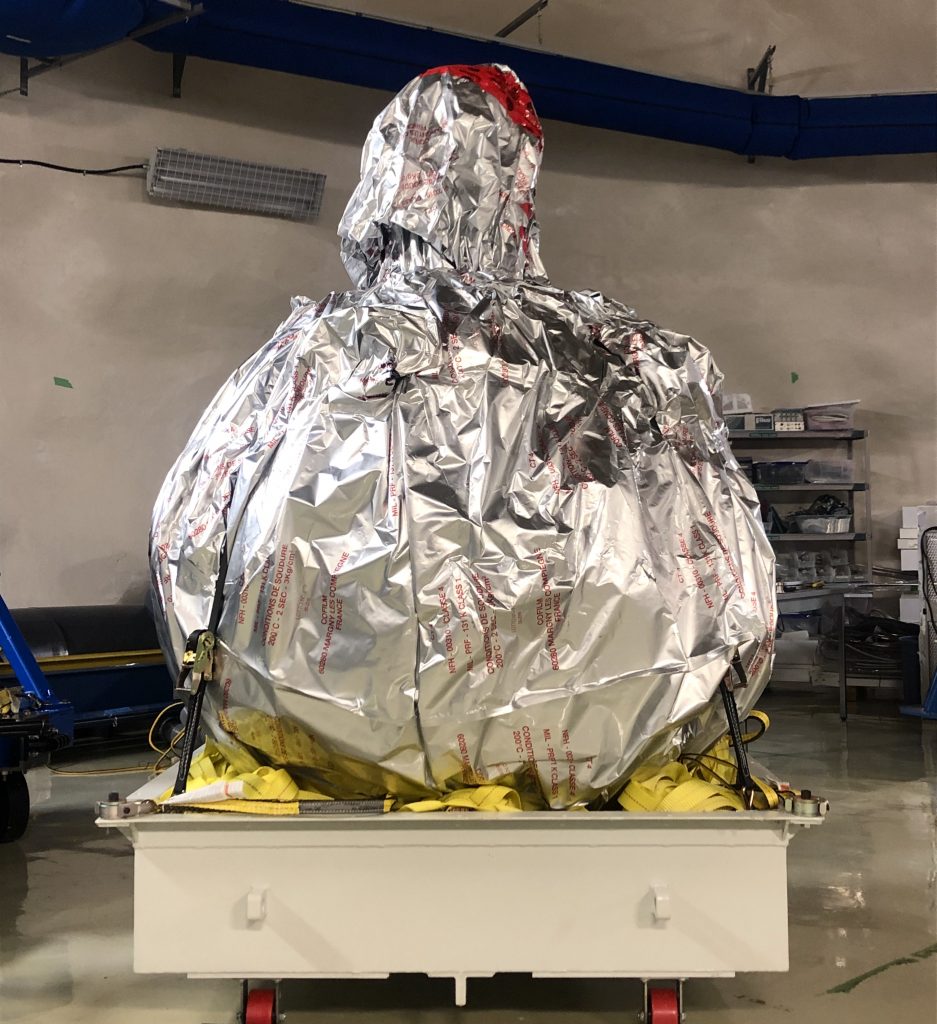NEWS-G detector arrives at SNOLAB

NEWS-G, one of the dark matter detectors that will be installed at SNOLAB in 2020, is slightly different from most of the dark matter experiments operating here. Experiments like DEAP-3600 and PICO 40 are searching for ‘heavy’ WIMPs, dark matter particles that would have enough mass to affect the argon or C3F8 they collide with in the detector. NEWS-G is looking for ‘light’ dark matter, so needs to have lower mass target material. Think of it like throwing a ping pong ball at a tennis ball rather than a bowling ball: the tennis ball will actually move. NEWS-G is using light gases as a target (hence the name of the experiment: New Experiment With Spheres – Gas).
The detector itself is a copper sphere with a positively charged anode in the middle. When a dark matter particle collides with a gas atom inside the detector, the gas will ionize, releasing an electron which is attracted to the anode. The electron then travels to the anode, creating an electrical signal recorded by the detector. NEWS-G uses a spherical detector because a sphere has the highest volume to surface area ratio. Most background events recorded by detectors happen on or near the surface, so maximizing the volume helps reduce background events.
The NEWS-G detector arrived on site last week, and is currently in the cryopit undergoing a nitrogen purge while the rest of the experiment components arrive at SNOLAB. When NEWS-G is complete, the detector itself will be surrounded by lead shielding. The lead will arrive in six pieces and be shipped underground to be assembled. These lead pieces are creating some challenges for the NEWS-G team: one piece of lead, the base piece, is the heaviest single object that SNOLAB has ever brought underground combined with the stand that it sits on, it weighs about 75,000 pounds. Every step of its journey to the lab needs to be carefully coordinated.
To reach the cube hall where NEWS-G will be set up, experiment components need to arrive on site, be transferred to the collar and loaded onto the cage, travel 2 km underground, be pulled off the cage and through the 1.5 km drift on rail tracks, be brought into the SNOLAB carwash and cleaned, be transported through the lab to the top of the cube hall, and then lifted by crane down to the cube hall floor which is 5 storeys below.
To get the piece of lead shielding underground, the team has to do most things a little differently because of how heavy it is. The lead is being delivered right to the shaft station, rather than to SNOLAB, because transporting it across the mine site by forklift isn’t possible. Because of this, the six pieces of lead need to be delivered one at a time – a new one can’t arrive until the previous one has made the trip to the underground lab. Before the lead is loaded into the cage, it will be lifted onto a railcar reinforced with a ¾ inch steel plate to spread out the weight. Nothing else can be brought underground on the same run because that single piece of lead shielding puts the cage nearly at its maximum allowable weight.
Arriving at the 6800 level, the reinforced railcar will be pulled off the cage and towed through the drift by the diesel tugger used to transport items to SNOLAB – though it may also need to get a push from behind by a forklift to successfully move the lead. Two 12 ton hitches have been installed at the dirty side carwash to bring the lead into the lab itself. There, it will be cleaned and wheels added to the stand it sits on. A rented tractor will tow the lead through the lab to the top of the cube hall, where it will undergo the final step of its journey. The lead is too heavy for the cube hall deck area, so an overhead crane will lift it directly from the staging area over the deck and down to the cube hall floor. There, it will eventually be assembled around the detector to provide additional shielding for the NEWS-G detector.
The lead is scheduled to begin arriving on site in January, and the experiment plans to begin assembly underground in the new year.
– Jenna Saffin